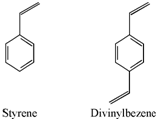Addition polymers:
The area of synthesis of ion exchange resins is now dominated through addition copolymers prepared from vinyl monomers. They are more chemically and thermally stable than the condensation polymers. However, further polymerization, the degree of cross-linking and particle size is easy to control. A well known cation exchange resin is obtained through the copolymerization of styrene and a small proportion of divinylbenzene followed through sulphonation by treatment along with concentrated sulphuric acid or chlorosulphonic acid.

The role of divinylbenzene is as a crosslinking agent. The Pure divinylbenzene is not easily available. The commercial product consists of various divinylbenzene isomers (around 50%) and ethylenestyrene (around 50%). Thus, ethylenestyrene is also introduced in the matrix. The degree of crosslinking can be adjusted through varying the divinylbenzene content.